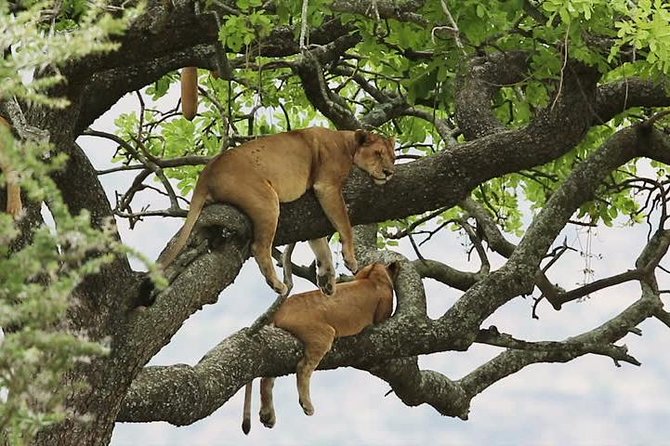Before we go to the Guide to see tree climbing lions in Queen Elizabeth National Park, let us learn about them first. The tree climbing lions of Queen Elizabeth National Park are a unique and fascinating phenomenon. Unlike most lions that are known for staying on the ground, a particular population of lions in the Ishasha sector of Queen Elizabeth National Park has developed the behavior of climbing trees. Here are some key facts about the tree climbing lions of Queen Elizabeth National Park:

Behavior:
The tree climbing lions of Queen Elizabeth National Park have adapted to their environment by regularly climbing and resting in fig trees. This behavior is not commonly observed in other lion populations.
Ishasha sector:
The tree climbing lions are primarily found in the southern part of Queen Elizabeth National Park, particularly in the Ishasha sector. This area is characterized by large fig trees that provide shade and comfortable perches for the lions.
Reasons for climbing trees:
The exact reasons why these lions climb trees are not entirely understood. Some theories suggest that tree climbing allows them to escape the heat on the ground, avoid annoying insects, or get a better vantage point for spotting prey or intruders.
Tree preferences:
The lions in Queen Elizabeth National Park show a preference for certain types of trees, especially fig trees. These trees have sturdy branches that can support the weight of the lions.
Climbing ability:
Lions are not natural climbers, and their tree climbing ability is somewhat limited compared to other tree-dwelling species. However, they have strong forelimbs and sharp claws that help them ascend and descend trees.
Viewing opportunities:
Spotting the tree climbing lions in Queen Elizabeth National Park can be a thrilling experience, but it requires some patience and luck. Game drives in the Ishasha sector offer the best chance of seeing these unique lions in their natural habitat.
9 Days Tree lions, wildlife and chimpanzee tour
3 Days Queen Elizabeth wildlife and experiential lion and leopard tracking safari
Other wildlife:
While searching for the tree climbing lions, you can also enjoy the abundance of other wildlife in Queen Elizabeth National Park. The park is home to elephants, buffaloes, antelopes, hippos, crocodiles, and a variety of bird species.

Remember that wildlife sightings are never guaranteed, and the tree climbing behavior of lions is not constant. However, the Ishasha sector of Queen Elizabeth National Park remains one of the best places in the world to observe these remarkable lions in their tree-climbing habitat.
This is the ultimate guide to see tree climbing lions in Queen Elizabeth National Park on your Uganda safari.
Plan your visit:
Start by determining the best time to visit Queen Elizabeth National Park. The dry season, from December to February and June to July, is generally recommended for wildlife viewing. However, tree climbing lions can be spotted year-round.
Accommodation:
Book your accommodation in advance. There are various lodges and campsites within and around the national park that offer comfortable stays.
Hire a guide:
It’s highly recommended to hire a knowledgeable guide or join a guided safari. They are familiar with the park, know the lion’s behavior patterns, and can increase your chances of spotting tree climbing lions.
Game drives:
Take part in game drives within the park. These are typically in open 4×4 vehicles and provide the best opportunity to spot wildlife, including the tree climbing lions. The guides will know the lions’ favorite trees and areas they frequent.

Ishasha sector:
Head to the southern part of Queen Elizabeth National Park, specifically the Ishasha sector. This area is for its tree climbing lions. While lions in other parts of the park may occasionally climb trees, the Ishasha sector has a higher concentration of this behavior.
Patience and timing:
Spotting tree climbing lions can require some patience and timing. Keep in mind that these lions are still wild animals, and their behavior is not a guarantee. Spend enough time on game drives, focusing on the areas also known for tree climbing lions.
Early morning or late afternoon:
Lions are generally more active during the early morning or late afternoon when temperatures are cooler. Plan your game drives during these times to increase your chances of sighting tree climbing lions.
Look for clues:
Keep an eye out for signs of the lions’ presence, such as claw marks on tree trunks, fresh tracks, or even other animals’ alarm calls. These indicators can help your guide locate the lions more efficiently.
Respect the animals:
When you do spot the tree climbing lions, maintain a safe distance and respect their space. Do not disturb or provoke them, and follow your guide’s instructions for the best wildlife viewing experience.
Enjoy the other wildlife:
While searching for tree climbing lions, take the opportunity to enjoy the other wildlife in Queen Elizabeth National Park. The park is home to a diverse range of animals, including elephants, buffaloes, hippos, and various bird species.
Remember that wildlife sightings are not a guarantee, but by following these tips and with a little luck, you’ll have a better chance of seeing the tree climbing lions in Queen Elizabeth National Park.







